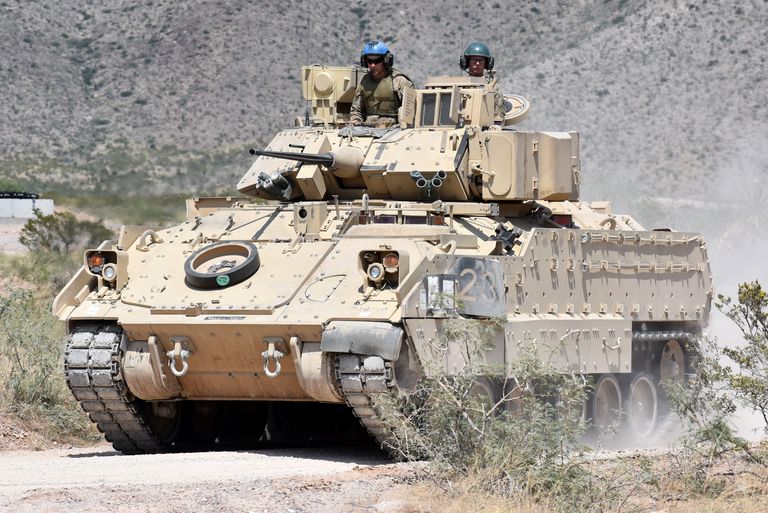Here’s a short video of the KF41 at the recent NATO Brave Warrior exercises in Hungary, literally driving circles around the M2 Bradleys it might soon replace. The KF41, of which only one is currently in existence, was in Hungary where it had won a competition for 218 new infantry fighting vehicles.

The latest version of the M2 Bradley, the M2A3, 2018.
The U.S. Army’s next-generation infantry fighting vehicle could feature German DNA. German defense contractor Rheinmetall is teaming up with American defense contractor Raytheon to offer the company’s KF41 Lynx infantry fighting vehicle to the U.S. Army. The Army is looking to replace its thousands of M2 Bradley fighting vehicles with a newer design that is not only better in every way, but also has the ability to be remotely controlled on the battlefield.
The M2 Bradley was first used by the U.S. Army in the 1980s. The vehicle not only could carry infantry, but also offered enough protection to allow them to remain mounted during an attack. This preserved the momentum of an armored assault, ensuring that the attack did not slow down and that dismounted infantrymen didn’t need to be rounded up and board the vehicle to continue an offensive.
The Bradley first saw combat in the 1991 Gulf War, then the 2003 invasion of Iraq and the 2014 war against the Islamic State. Along the way the Bradley has gotten heavier with the introduction of new armor, electronics, and other systems that allowed the vehicle to pace battlefield threats.
After 30-plus years, however, the Army has decided it’s time to start over with a new vehicle that incorporates new tech from the ground up.
German defense contractor Rheinmetall, which developed the M256 gun on the M1A2 Abrams tank, is tossing its hat into the OMFV ring with the KF41 Lynx. KF41 is a tracked vehicle with a crew of three and the ability to carry eight infantrymen and women in the rear. Lynx is armed with a Lancer 2.0 turret incorporating a 35-millimeter autocannon, and the step up in caliber will allow Lynx to engage light armored vehicles and enemy troops at longer ranges at the expense of less onboard ammo.
The Rheinmetall LYNX KF41 (KF stands for “Kettenfahrzeug”, or tracked vehicle in German) is a German-made next-generation family of vehicles that offers state-of-the-art firepower, mobility and protection. The LYNX consists of a modular design that comes in two primary versions: the KF31 and KF41. Both versions have a driver in the hull and a two-man crew in the turret. The engine is in the front and the exhaust in the rear. Weighing up to 38 tonnes, LYNX KF31 can seat 3+6 soldiers.
LYNX KF41 is slightly larger and can carry 3+8 soldiers. Rheinmetall’s LANCE turret for the KF41can support a 30mm or 35mm cannon and the turret ammunition is separated from the crew for added protection. Both versions can be configured for IFV, C2 (command and control), reconnaissance, repair and recovery, and ambulance variants. The vehicle interior has a spall liner, decoupled seats, and mine and IED protection packages that can be exchanged in the field. The KF41 does not have a V shaped hull, but its mine protection is highly effective against heavy blast mines, explosively formed projectile mines and IEDs. The KF41 also has passive and reactive systems to defeat rocket-propelled grenades and antitank guided missiles and provides roof protection against cluster munitions. Rheinmetall’s SOLAR SIGMA Shield Mobile Camouflage System can also be fitted to the entire vehicle to reduce heat loading as well as thermal and IR signatures.
The KF41 weighs 44 tons, significantly more than the 30-ton Bradley. The KF41 is bigger but it’s also more agile, with a horsepower to weight ratio of 26 to 1. The Bradley’s, by contrast, is about 21 to 1.
The KF41 in U.S. Army service would probably look a little different than the vehicle seen in Hungary as the U.S. may want the turret to be equipped with two long range anti-tank missiles, giving OMFV the ability to take on tanks by itself. It may also want an active protection system capable of detecting and shooting down incoming rockets and anti-tank guided missiles. Lastly, KF41 may need the ability to be operated remotely.
Rheinmetall is competing for the Czech IFV contract with their LYNX vehicle that was first shown at Eurosatory in 2016. Two main variants are available: LYNX KF31 with three crew and six dismounts or LYNX KF41 with three crew and eight dismounts. Both are fitted with the Rheinmetall LANCE turret system. The turret will accommodate the MK30-2/ABM 30×173 mm cannon; it can also be fitted with a launcher for the Rafael SPIKE-LR missile system. The Czech Land Forces already use SPIKE-LR on their PANDUR II vehicles.
The new OMFV program will probably run into 2021, or even 2022. It may even fail, yet again, to produce a replacement for the Bradley. If the KF41 does win however it could produce a vehicle that will be the main heavy infantry carrier for the U.S. Army to 2050 and beyond.